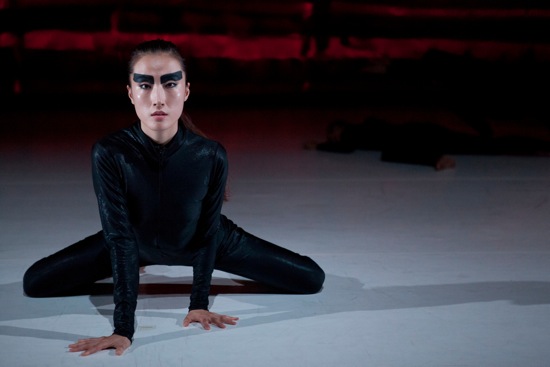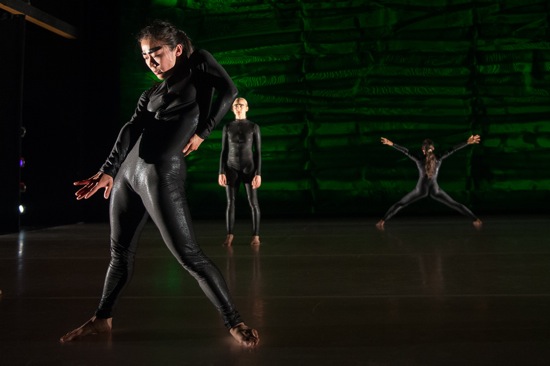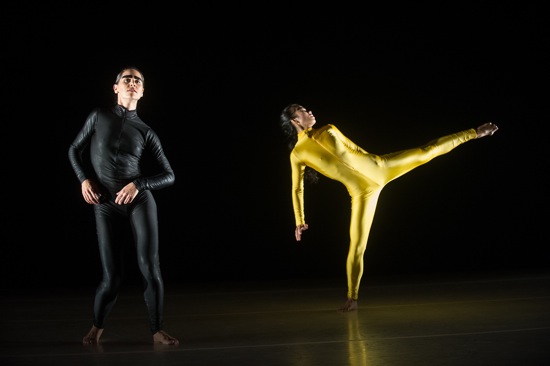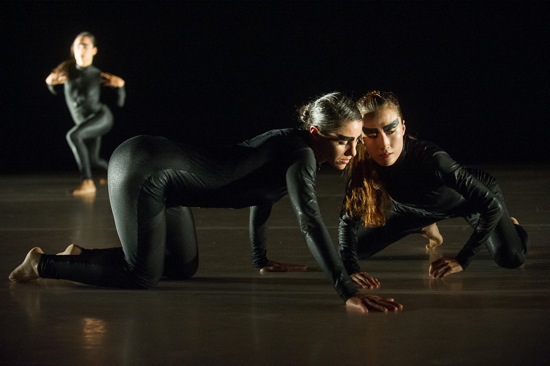LeeSaar The Company brings its latest work to Jacob’s Pillow, August 20 through 24
I have to believe that titles matter to Lee Scher and Saar Harari, the artistic directors of LeeSaar The Company. Their latest extraordinary piece of choreography is called Grass and Jackals. So I open my mind to tall grass that bends in the wind, lies flat under a hard rain, and can be a good hiding place. And jackals? They pack like wolves. They squabble and mate and take care of one another like members of some human communities I can think of. That they feast on carrion is probably not an attribute Scher and Harari were thinking of. But the alertness that all wild animals have certainly enters Grass and Jackals. Think piercing gazes, sharp changes of focus, pricked ears, the ability to freeze at an inkling of danger.
The seven women of LeeSaar The Company, which closes the 2014 Jacob’s Pillow season, are expert at all of these, and at much, much more. Jwe-Hwei Lin, Hsin-Yi Huang, Hyerin Lee, and Candice Schnurr have all worked with Harari and Scher for six years or more. Motriya Kozbur, Isabel Umali, and Delphina Parenti are more recent recruits. All dance with the hunger and daring that characterize LeeSaar’s dances.
And, since Harari and Scher were influenced by the Gaga technique developed by choreographer Ohad Naharin in their native Israel, their dancers (whom they term “creative performers”) are astonishingly attuned to minute changes in their bodies, even at the cellular level. This translates as complex interactions of joints and muscles, spines that seem almost boneless. The performers move fluidly through positions that we (if we could assume them at all) would have to stop and think about. And, since they are not really jackals, we sometimes glimpse a strutting runway model, an expostulating mother, or a reclining beauty.
The lighting by Avi Yona Bueno (Bambi) creates a weather that seems sometimes emotional and sometimes a process of nature. A pool of light with undefined edges may appear. Low amber sidelights may throw shadows, and—most spectacularly—a projection occasionally makes the rear wall of the Doris Duke Studio Theater look like a luminous, horizontally crumpled red curtain (or a green one, either pale or emerald). Harari has edited a remarkably coherent musical score made up of excerpts from thirteen compositions by others (for example, Erik Wøllo’s “The Land of Birds,” Brian Eno’s “Complex Heaven,” and “Sunshine” by CocoRosie). Often, a melody swims above a slow, steady beat and a deeper continuous sound. A quiet ticking sneaks in. A husky voice sings as if she and her musicians are down in a well. Silences fall with tremendous weight.
The opening image is a thrilling one. The stage is very dimly lit; you can barely make out a tight pack of black-clad figures on their hands and knees, facing a diagonal. As they progress almost undiscernibly, they place their hands from side to side so that they sway as a unit. You can image the earth moving. One of them breaks away and stands in a corner near the audience, thrashing about. Pretty soon, all of them are on their feet and on the prowl. Whatever individual directions they may take, they’re a tribe. Not only are they dressed in tightly fitting, slightly shiny black coveralls (by Naomi Luppescu), but their eyebrows have been replaced by broad black patches of makeup. Their hair is skinned back from their pale faces, although some of them have ponytails that lash behind them.
They are fascinating to watch—spellbinding. It’s pointless to speculate why they do what they do, even when Hsiang and Lin briefly face each other down and talk—with Lin shrieking and growling her words. Even when Lin reappears in an all-yellow outfit and joins her colleagues (next time we see her, she’s in black again). This is their world, and they are going about their business. I feel my own eyes sharpen, my breath quicken and subside.
They have other missions outside the boundaries of the performing space, so they come and go. You may focus on three of them or a succession of brief solos. All may perform different phrases simultaneously or fall into scrupulous unison. One minute they look like a stealthy army; the next they’re shouting with their bodies—taking big spraddled steps with their knees bent and their feet wide apart, or clawing the air as if they snatching big gobbets of it. They rest too, sometimes curled on their sides, sometimes sprawled.
This group is athletic. Its members rush into big grabby jumps; they kick their legs high. It’s astonishing how rapidly and fiercely they can make their entire bodies quake—less in fear than in preparation for something. Yet the extreme ways in which they swing their hips around, splay their legs, and stare at us boldly seem like an enticement. In a solo, Hsiang stands in one place and slides her feet around as if the floor were ice and she were sending us a seductive message with her rippling body. We’re the people across the stream from these women, and we cross it at our peril. They can seem vulnerable, though. That’s never clearer than when they position themselves like frogs—bracing themselves on their hands, kneeling on bent, turned-out legs— and examine us.
They often cluster, but rarely touch one another with their hands. It’s a shock when Hsiang and Parenti grasp each other’s heads and adopt combative positions or attempt choke holds; they break apart to dance in unison, then tangle their way offstage. Brief images appear that suggest coupling. Pairs freeze in an embrace. When Lin enters in her yellow costume, each of the others places a hand on the nearest person’s shoulder and gazes at us, or beyond us. But for the most part, they express their unity by doing the same things—laughing briefly or biting the air or running around with their index fingers to their lips. (Whom are they shushing?)
Everything is curious, yet curiously familiar. Organic. Perhaps a ritual is emerging or a process of nature. The ending of Grass and Jackals is as much of a marvel as its beginning. Lin tears open her black suit to reveal a shiny gold one underneath it and shrugs her way out of the dark carapace. As she does so, extremely thin transparent threads begin to fall from above; silvery in the light, they create a gleaming curtain between the fantastic performers and us. The increasing precipitation looks like rain, but the clumps it forms resemble snow (the stuff is actually, I learn, a kind of glue). The women walk slowly away into darkness, but at the last minute, Lin turns her head to look at us one last time.




